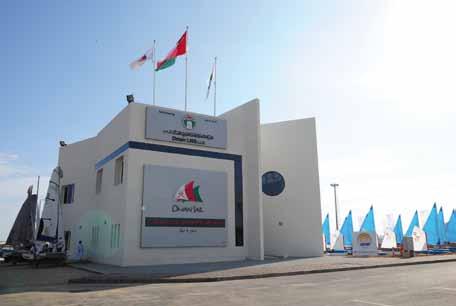
22 minute read
Reports from the Regional Coordinators
by IGU
Report s from t he Regi onal Coordin ators
In this issue we bring you reports from IGU’s Regional Coordinators for Europe, and for Latin America and the Caribbean.
New era for gas in the European market
By Andrea Stegher Europe is the world’s largest importer of natural gas with net imports of piped gas and LNG amounting to 304 bcm in 2017. Gas demand in the region has recovered in recent years after the economic downturn and due to the progressive coal-to-gas switch in electricity generation. Demand was 532 bcm in 2017 compared to the recent low of 459 bcm in 2014.
The European gas market is also a mature one and is facing the need to continue transforming itself to deal with progressive challenges, deriving from the evolution of supply-demand
trends and, looking more into the future, achieving technical innovations to meet decarbonisation targets defined at the political level.
In terms of the demand-supply balance, Europe will need – whatever the demand scenario – to cope with progressively declining domestic production and therefore to rely more on imports, both from existing sources and new ones. This will require investments to allow new flows to serve the market and to better interconnect national markets. Gas will need to flow in a more flexible and fluid way, improving the intrinsic features of the gas market in terms of reliability and security, both in volumes and peaks, to guarantee energy to all consumers under all circumstances.
c The 2020 global sulphur limit for marine fuel oil will pave the way to a much bigger role for LNG in bunkering. Shell’s Cardissa supplies LNG as marine fuel from the Gate Terminal in Rotterdam to ports across northwest Europe.
LNG is already playing a greater role in providing flexible gas in many European markets. Coupled with ample underground storage capacities, which are a crucial element of the European system, LNG is becoming a powerful lever to enhance gas competitiveness.
The European market is also building on its maturity to preserve gas demand in the traditional heating and cooling, industrial and power generation sectors. Especially in power, gas is the swing energy source between fast-growing renewables and “cheap” coal. But gas is also moving fast to gain new market share in the transportation sector, where the use of LNG and CNG can be instrumental in improving air quality by achieving a significant and immediate result in terms of emissions reduction (-40% CO 2 ) and especially particulate matter (-90%). Moreover, the incoming global sulphur limit for marine fuel oil set by the International Maritime Organisation will pave the way to a much bigger role for LNG in bunkering.
Gas in a decarbonising economy
But trends, figures and projects must be looked at in a different light considering that Europe is strongly
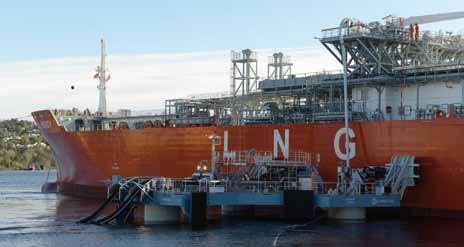
Europe’s gas industry has a proud record of technological innovations – Naturgy in collaboration with Norwegian Connect LNG has developed the first floating ship-to-shore LNG transfer system called DirectLink LNG.
committed to achieving carbon emissions neutrality by 2050. In this respect, the gas industry as a whole – and IGU in particular – has done good work to promote the role of gas, but additional efforts are needed to allow the industry, the general public and policymakers to improve their understanding of the overall contribution of gas to meeting energy demand, in a context of increasing urgency as regards climate targets.
IGU’s recent decision to nominate – after a two-year vacancy – a European Regional Coordinator is indeed a good signal about the intention of the Union to better engage and contribute to the debate, promoting and enhancing the “role and new era” of gas for the long term.
And when I speak about the “role and new era of gas”, this is to be considered by widening the traditional picture, taking technological innovation as a key parameter to build upon. IGU, with its deep and extensive industry expertise, is very well placed to stimulate not only fact-based position papers and policy debates, but crucially it is central to the promotion of conditions around which innovation to achieve gas “carbon neutrality” can be reached.
Today the gas industry is looking for technological proposals in many areas: from methane leakage detection, measurement and mitigation that are well under way, to less immediate issues, like carbon capture and storage (CCS) and carbon capture, use and storage (CCUS). Moreover, there are other developments – sometimes labelled as “lateral” – that could contribute to climate targets, such as biomethane and hydrogen (also coming from power-to-gas projects), which have to become an integral part of the “gas” narrative.
IGU members are committed to piloting and deploying technologies that have reached appropriate maturity and IGU should stimulate additional combined projects to help industry innovation. This will be a crucial matter for our associates, activities and people.
Furthermore, these targets could be enhanced by renovating and redefining partnerships with key industry regional stakeholders (e.g. GasNaturally) to create shared platforms and a common language, to maximise the effectiveness of results and allow all IGU members to benefit from them.
Some preliminary takeaways
Natural gas will play a significant role in Europe’s energy transition and can also be essential in the long-term, but to maximise its potential more has to be done. The natural gas industry is committed to developing innovative technologies to promote decarbonisation, reduce emissions and contribute to the energy transition. IGU, representing most of the European gas industry players, needs to engage positively in promoting technological innovations and solutions for gas, which policymakers can value in the framework of carbon-neutrality targets, to ensure the long-term role of gas.
As well as supporting the regional market, IGU’s work in Europe would, very evidently, have a positive spillover effect to all regions, where climate targets are progressively being set as fundamental elements of local policy developments. Thus, Europe can be considered an important “laboratory” to test the future resilience of the gas industry, while continuing to foster a
good investment climate for the companies involved in the business. IGU, together with other relevant industry stakeholders, has a crucial role in promoting this pathway.
As IGU Regional Coordinator for Europe I will strive to stimulate and promote the increasing role of gas and of IGU as a fundamental stakeholder in the region, benefiting from the support, stimulus and challenges of my fellow European IGU colleagues and, for sure, from contributions coming from members outside the region, in the spirit of best serving all IGU members.
Andrea Stegher is Senior Vice President, Marketing Global Solutions at Snam and the IGU Regional Coordinator for Europe.
Latin America: A region of opportunities and challenges
By Orlando Cabrales Segovia Gas consumption since 2010 has been growing about 1.8% each year, making this fuel the second fastest growing energy source in the world. In addition, in the long term it will surpass coal and become the second largest fuel in the planet’s energy matrix, owing this increase mainly to industrial consumption and LNG trade to satisfy the needs of developing economies.
Regarding Latin America, consumption grew by 0.4% in 2017, which represents an advance compared to

TransMilenio is renewing Bogota’s bus rapid transit system with gas-fuelled vehicles including the bi-articulated Scania F340 HA 8×2.
2016, but still does not reach the levels achieved in 2010 when the growth rate was 4%. However, it is expected that demand growth in 2040 in Central and South America will be 1.9% per year and production will increase by 2.1%, with Brazil and Argentina being the main players. The share of gas in the energy matrix of the region is expected to reach 25%.
This region has great potential to position natural gas as a necessary fuel to contribute to the social and economic development of our countries, tackling energy poverty and providing a flexible and competitive fuel to industries and transportation. Air quality is a major concern in the main cities across the region and natural gas has a key role to play given its environmental advantages.
Although Argentina and Brazil showed slight increases in consumption, countries such as Chile, Colombia, Peru and Venezuela presented negative figures due to lower production and lack of infrastructure in some cases.
A focus on the countries of the region
After 10 years, Argentina has begun to export gas to Chile again. There are high expectations regarding the development of Vaca Muerta, which would significantly increase the supply in the upcoming years. In order to take full advantage of its resources, demand must be developed through exports, transportation and petrochemicals.
Bolivia has a great opportunity to develop demand through petrochemicals. Gas integration and access to new markets via the Pacific (through Peru) and the Atlantic (through Argentina) will heavily depend on attracting investment in exploration and the construction of new infrastructure.
Brazil is known for having an energy matrix with a large share of hydroelectric power plants. This requires significant amounts of natural gas during the dry season to back up the
electricity system. Associated natural gas in the pre-salt is expected to breakeven in the medium term and could become a significant source of supply to the region and the world.
In the case of Colombia (the country where I am based), the strategy has been to increase demand for natural gas mainly in the public transportation systems of the main cities and in industry.
On the one hand, in 2018 we surpassed 9.5 million users in households, commerce and industries. The number of vehicles converted to use natural gas rebounded in 2018 reaching 20,000, well above the target we had of 12,000. In addition, we ended up last year with more than 800 large gasfuelled vehicles in the public transport, cargo and refuse truck fleets. An important milestone following a large order in November 2018 is that 52% of the new fleet of TransMilenio, the public transportation system of Colombia’s capital city, Bogota, will be fuelled by natural gas.
In terms of the outlook for the coming years, additions of natural gas reserves in Colombia could come from the Caribbean offshore and shale gas in the middle Magdalena valley. Colombia has a robust and comprehensive regulatory regime that ensures that fracking is carried out with high technical and environmental standards.
Chile has great opportunities to improve the air quality of Santiago through the use of natural gas in transportation. Peru will have to develop new reserves and invest in gas infrastructure if it wants to maintain exports, fuel power generation and deepen the penetration in households.
Also, it is worthwhile highlighting Guyana’s new role as a player in the oil and gas industry, owing to the massive offshore discoveries recently made. It could definitively be a game changer for the region.
Finally, I would like to highlight the needs that Mexico has to invest in all the value chain, mainly in the upstream to increase production and reduce the dependence on US imports. It is still uncertain how much of the energy reform conducted in the last years will be maintained by President López Obrador.
Each country in the region has lessons learned to share with each other in terms of the effectiveness of energy policies in attracting investment and developing new sources of supply and infrastructure. A key challenge is to further integrate the countries by building infrastructure and increasing the energy exchanges among our countries. No doubt, more integrated energy systems will be key
v Peru LNG has an export capacity of 4.45 mtpa but the country needs to develop new reserves for the future. to resolving political differences more easily whenever they arise.
Increasingly, the citizens of Latin America are becoming aware of the damage that pollution does in their lives and are demanding alternatives to improve air quality. According to the World Health Organisation, every day about 93% of the world’s children under 15 (that is, 1.8 billion children) breathe air that is so polluted that it puts their health in serious danger. Needless to say, the situation is more dramatic when there are still hundreds of millions of people living in homes that cook with wood and coal.
Natural gas in the region will continue to play a key role in meeting the environmental commitments of the Paris Agreement, contributing to an energy transition that demands cleaner sources of energy, and ensuring that families and businesses have a more accessible and competitive fuel.
Orlando Cabrales Segovia is the CEO of Naturgas and the IGU Regional Coordinator for Latin America and the Caribbean.
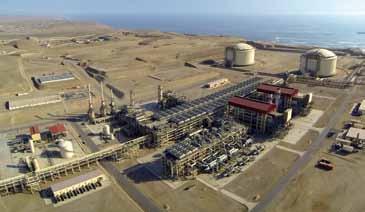
A better world
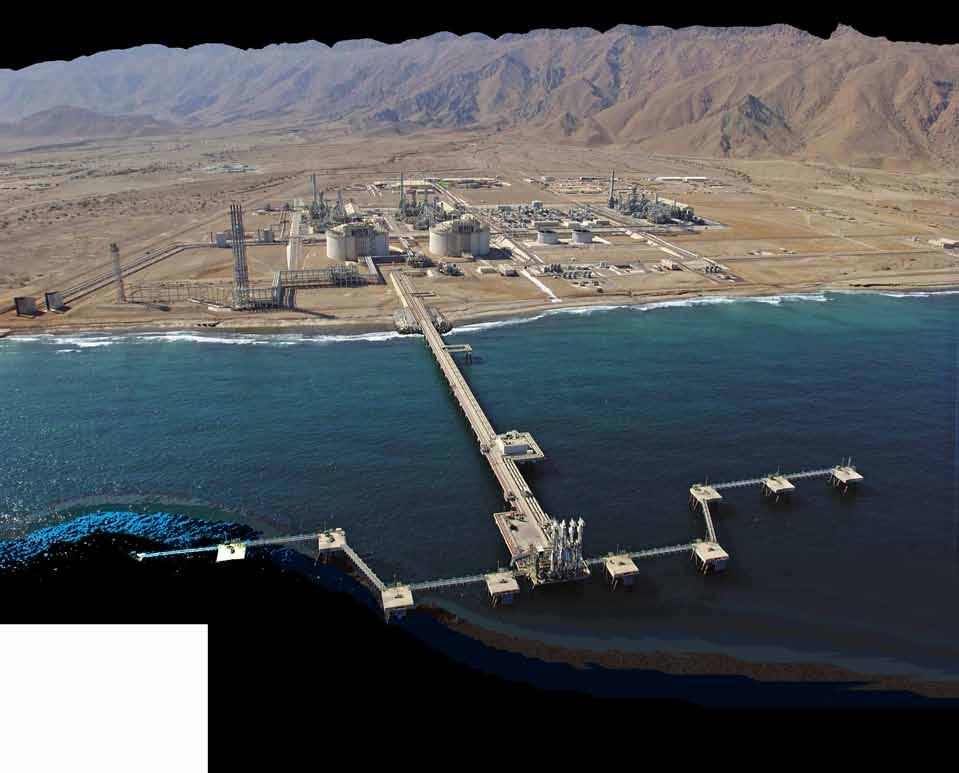
With natural gas as the world’s cleanest and most efcient fossil fuel, Oman LNG’s operations near the Omani city of Sur, is helping to make for a better world. Since starting production in 2000, we have delivered over 2,300 cargoes to customers, remaining a reliable supplier ofliqueed natural gas that is helping to reduce carbon emissions and preserve the earth’s natural environme nt for future generations to enjoy.
For centuries, this beautiful coastbound nation of Oman was a trade centre connecting different parts of the world through vibrant and ourishing commerce relations. Trade that supported lives in far lands. At Oman LNG, we continue that tradition of seafarers and commerce through bringing energy to many corners of the world.
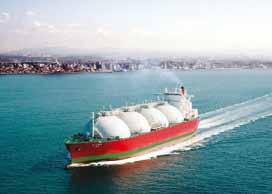
Oman Liqueed Natural Gas LLC (Oman LNG) is a joint venture company established by a Royal Decree in 1 994 operating under the laws of the Sultanate of Oman. The company engages in the business of producing and selling liqueed natural gas (LNG), and its by-product, natural gas liquids (NGLs) and operates three liquefaction trains at its plant in Qalhat, South Sharqiyah Governorate.
Hand-in-hand with our operations comes a strong health, safety and environment performance. Our recent achievement of over 30 million manhours without a Lost-Time Injury (LTI) is testament to our HSE excellence, and an exemplary diligence and commitment to the safety of our people, environment, and communities where we operate. Our processes meet the highest of ISO standards, which we are proud to maintain every year and our ceaseless effor ts to support the environment through the sponsoring of various initiatives such as the Turtle Reserve in Ras al Jinz in the eastern region of the country boasting one of the world’s largest breeding beaches for Greenback Turtles.
As a company our responsibility to our staff, contractors and the community is to provide a safe environment so that they can come to work and return home to their fa milies, safely every day.
Through our empowerment philosophy, we continue to develop talent and help remove barriers to reach success. Our aim is to develop all staff to their fullest potential. We support incountry value through focused efforts towards developing local talent and

stimulating local business ventures by enabling Small Medium Enterprises (SMEs), a major cornerstone of Oman’s econo my, to ourish and providing equal opportunities to compete for all service contracts.
The company is a corporate and social responsible organisation by maximising benets to the employees, stakeholders and community and has a well-designed alignment between sustainable social development and the business.
From powering large industries, to keeping homes warm and the lights on, Oman LNG is your rel iable energy partner.
Perpetual sustainable investments in the society ofOman
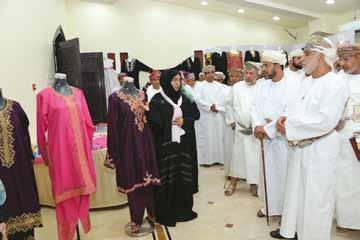

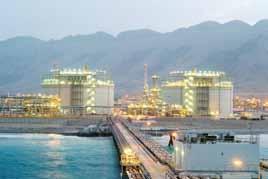
Corporate Social Responsibility (CSR) has been an integral part of Oman LNG with a focused objective: to deliver tangible value to Oman and its people through social investment by capitalising on the country’s natural gas resource. The company allocates annually 1 .5% net income after tax (NIAT) to various social investment and sustainable programmes; a commitment set when the company was founded. In addition, before the rst cargoes left the LNG plant, the company invested in sustainable development projects for the community which speaks volumes about the company’s business principles; that Oman LNG’s initial investment in social development began even before the production li ne was fully functional.

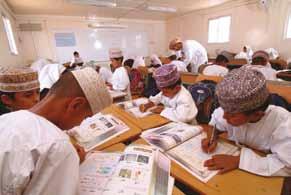
pany’s social investm ent programmes have spanned the length and breadth of the country with thousands of projects ranging from healthcare and education to preserving the environment and road safety; reecting its sincere interest to embed the principles of social responsibility as part of its core existence. Through strengthening the cooperation between the public and private sector, the projects and programmes a im to supplement the national economy and ambitious
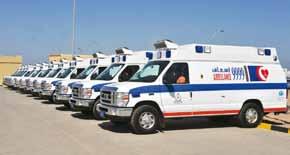
development the Sultanate. plans

implemented in
Oman LNG Development Foundation supports Oman LNG’s ambitious vision and dedication towards CSR. The Foundation champions private sector contribution to the development of Oman and its people, through CSR and citizenship, as an active contributor to social and societal welfare, and through proactively addressing community needs.
Today, Oman LNG’s CSR programmes, delivered through Oman LNG Development Foundation, span the entire nation and contribute to the socioeconomic development of the country. Over the past nineteen years, the com-
omanlng.com oman-lng-l-l-c- @OmanLNG Oman LNG omanlngllc
Situated in the extreme south-eastern corner of the Arabian Peninsula, the Sultanate of Oman has been popular as an oasis of peace, tolerance and tranquillity. Its 3,165 kilometre coastline runs northwards along the Arabian Sea, from the entrance of the Indian Ocean in the far south-west to the Sea of Oman and Musandam, where it overlooks the strategic Strait of Hormuz at the entrance to the Gulf.
From the fabled snow fall in Al Jebal Akdar to the mountain peak of the Jebal Shams, the Sultanate of Oman hosts a few of nature’s remaining wonders. One of such marvels is located on the pristine beaches of Ras al Jinz. On these beaches, near extinct greenback turtles maintain their own habitat.
The landscape of Oman is strikingly varied: cool lofty mountains cut by over 100-metre-deep gorges, seemingly endless simmering hot gravel planes, golden sand dunes and grey slate-flats which all attract tourists and geologists alike.
Modern
State
At the maturing age of forty-nine, Oman’s modern Renaissance has managed what must have once seems unimaginable: a state of progress, prosperity and opportunity that has touched its bounty on every Omani citizen. The citizen and government of the Sultanate have today countless reasons, accumulated over two generations, to be proud of the wise leadership, and to be grateful for its embodiment in His Majesty Sultan Qaboos Bin Said, Sultan of Oman.
It took vision and perseverance to see the need for infrastructure development that would be both stable and sustainable over the long term, and to envision how this would be attained. Two fundamental and powerful insights spearheaded the transformation. Firstly, it would be necessary to rally and cement a unifying national spirit as a priority; as a binding force around which to build the development endeavour, which would flourish only in a climate of security and stability. This was quickly, and fully, achieved. The second insight expanded on the first, recognising the need to embrace the citizen as full partner in the formulation and direction of the development process, so that the process itself might then be able to rely on the wealth of the engaged and intelligent human potential to carry it forward.
Modern
ec on om y
Oman has an economy in which oil provides the basic source of revenue and is used to finance the country’s infrastructure projects.
The five-year planning process, which the Sultanate adopted at an early stage of the modern state, has enabled it to develop the country robustly which guarantees that its oil revenue is distributed fairly throughout its far-flung regions.
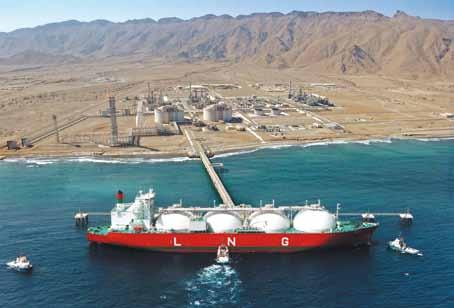
Despite the challenges posed on the global economy in general by the fall in crude prices – and particularly to those economies that depend upon oil as a primary source of revenue – Oman’s position has remained strong thanks to the stability of its own economy and its solid infrastructure, as well as the legislative framework supporting its economic and investment activities, the steady growth of its non-oil sectors and its trained and qualified national workforce. In addition, its general financial position, banking system, monetary policies and currency have remained solid and stable, so it is well placed to handle unexpected developments in the global financial markets.
Fl our ishing bus in ess
en vir onm
en t
Duqm lies outside the Gulf region, but remains close enough to take full advantage of the continuous flow of energy supply.
Oman is deploying all efforts to transfer the Duqm area to a renowned regional economic centre for trade, industry and investment. This is buoyed by the fact it is located strategically where it is boosted as an emerging preferred destination to world economies in the wake of the new global trade shift towards the Indian Ocean.
Such global interest in the Sultanate of Oman, as a regional base and an important strategic centre of economic and trade globally, has expedited energies supervised by the Omani government through the established government entity, ‘The Special Economic Zone Authority Duqm (SEZAD)’, where many people have described Duqm as a large workshop for projects that may leave a significant impact in the economies of the whole region. Currently, the region is witnessing establishment of many megaprojects that will enhance its leading role in the industry, trade and investment fields.
The SEZAD manages, regulates and develops all economic activities in Duqm. It plans, designs and implements long-term strategies for infrastructural development and attracts investments to promote a wide spectrum of economic activities. It also
oversees the urban expansion of the modern Duqm city while protecting the environment, thereby positioning Duqm as the preferred destination to visit, live, work and invest in the Middle East.
The SEZAD, is the official reference for potential investors. As a one-stop-shop solution, it registers, licenses and provides environmental approvals using the best international practices. Imports into the zone will be duty-free. Competitive future regulations such as potential company and investment registrations, labour, trade, land, taxation and incentives will be announced in due course. SEZ tax regimes, land lease rates, and utility tariffs will be provided at attractive rates. The SEZ is a model of an integrated economic development composed of zones: a sea port, industrial area, new town, fishing harbour, tourist zone, a logistics centre and an education and training zone, all of which are supported by a multimodal transport system that connects it with nearby regions (e.g., the Arabian Gulf countries, Middle East, East Africa and Southeast Asia). The SEZ is administered, regulated and developed by the SEZAD, a financially and administratively independent government entity.
With a land covering an area of 2,000 square kilometres and a 70 kilometre stretch of coastline along the Arabian Sea, the SEZ is the largest in the Middle East and North Africa region and ranks among the largest in the world. The SEZ has long been envisioned as the place that will balance regional development by energising the Al Wusta governorate in addition to diversifying sources of national income and creating job opportunities for Omanis.
Oman
LNG
From the first export of oil that left the shores of Oman in 1967, the Sultanate had over a period of two decades, become indelibly associated with oil as the main enabler of its economy. But by the first half of the 1990s Oman soon reached a new watershed in its illustrious history. Through a landmark Royal Decree issued by His Majesty Sultan Qaboos Bin Said in 1994, the groundwork for developing the country’s potential for gas was established to kick-start efforts geared towards utilising the nation’s gas resources. This would earn a new kind of foreign revenue, supplementing the income from oil and spur far-reaching initiatives to grow the nation’s economy.
Oman LNG is a tribute to that insightful Decree by His Majesty. Since delivering its first cargo to Korea’s KOGAS in 2000, the company has remained an enduring evidence of how Oman continues to fashion its progress while staying true to its traditional roots.
While revenue from the export of liquefied natural gas (LNG) contributes heavily to the country’s GDP, Oman LNG, through operating a three-train liquefaction plant in Sur, is the largest single private company investor in social development activities in the Sultanate, responsible for over 6000 CSR initiatives and projects.
The company’s involvement spans many essential areas of the economy including health, education, agriculture, women’s empowerment, sports, skills’-training, environment and culture, and has led to much advancement in these sectors.
Pr eser ving ol d cus
toms
It is an interesting contrast that the development of Oman’s LNG, a forward-looking fuel that many anticipate will eventually replace the wide usage of oil and coal in industries around the world also contributes to enhance the preservation of Omani cultural heritage.
Oman LNG is a keen advocate and supporter of preserving the Bibi Maryam Tomb in Qalhat. The history of the tomb is said to date back to the 14th and 15th centuries when Qalhat, then a thriving commercial nerve centre was frequented by travellers like Marco Polo. After a ravaging earthquake and raids by the Portuguese, the only enduring artefact of Qalhat’s impressive past is the tomb of Bibi Maryam, an outstanding woman who built “one of the most beautiful mosques in the world”.
The falaj water system, a source of irrigation water in Oman, is another ancient infrastructure championed by Oman LNG. Though many centuries old, this system of water supply is used for agricultural and domestic purposes in many parts of country. Both Bibi Maryam and the falaj water system are listed as UNESCO World Heritage sites.
The establishment of the Fatah al Khair ship-building museum and the renovation efforts to maintain Sunaysilah fort performed by the company, both located in Sur, home to Oman LNG’s world-class plant, are central in ensuring valuable history is preserved for future Omani generations and the world.
